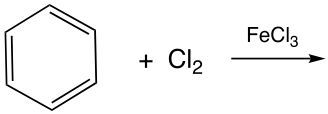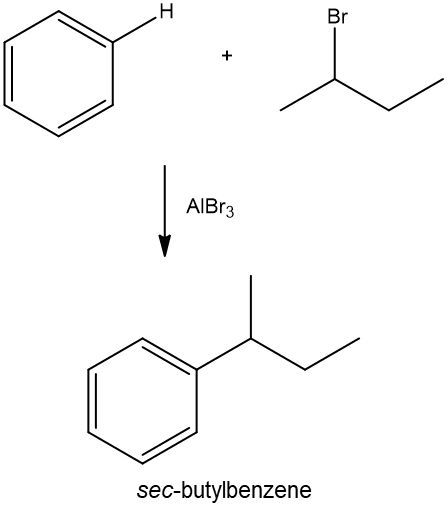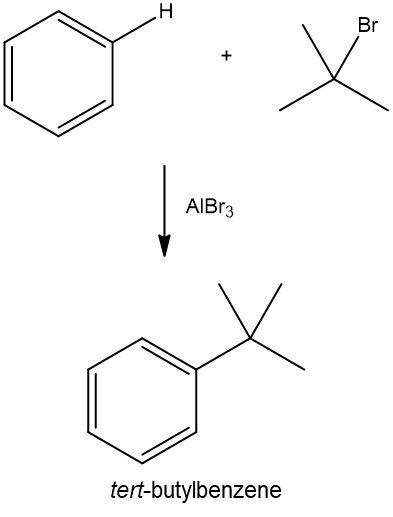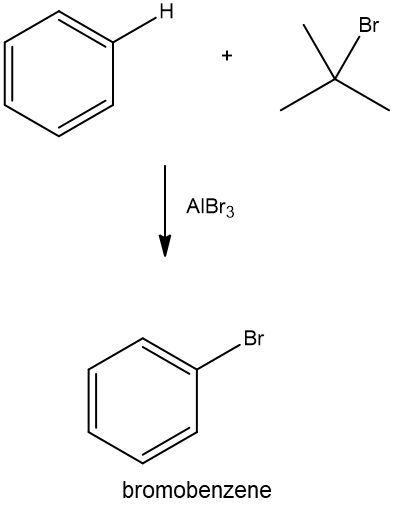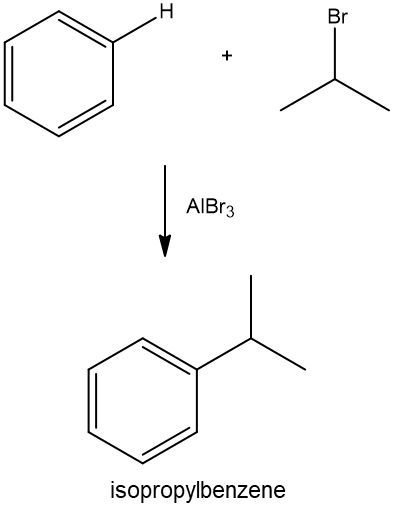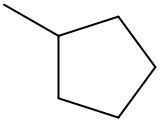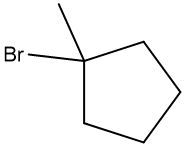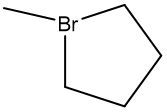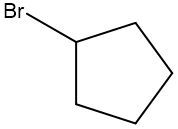Now we've seen benzene a few times within this chapter. Now benzene itself is what we call an aromatic compound. And aromatic compounds have an unusually or uniquely stable condition. Benzene possesses Pi bonds, but because of its aromaticity and its unique stability, it doesn't undergo additional reactions like we would expect. Benzene undergoes substitution reactions instead, and that's unlike alkenes and alkynes which do addition, because they have pi bonds, but they're not uniquely stable. Now here we're going to cover 2 types of substitution reactions that Benzene undergoes. One being Halogenation reactions, where we're substituting in a Halogen onto the Benzene ring, and then Friedel-Craft Alkylation, where we're substituting an alkyl group onto the benzene ring. So just remember, Benzene is pretty special. It's aromatic and very stable. It's gonna do substitution reactions instead of addition reactions, because it wants to maintain this very highly stable form that it possesses.
- 1. Matter and Measurements4h 29m
- What is Chemistry?5m
- The Scientific Method9m
- Classification of Matter16m
- States of Matter8m
- Physical & Chemical Changes19m
- Chemical Properties8m
- Physical Properties5m
- Intensive vs. Extensive Properties13m
- Temperature (Simplified)9m
- Scientific Notation13m
- SI Units (Simplified)5m
- Metric Prefixes24m
- Significant Figures (Simplified)11m
- Significant Figures: Precision in Measurements7m
- Significant Figures: In Calculations19m
- Conversion Factors (Simplified)15m
- Dimensional Analysis22m
- Density12m
- Specific Gravity9m
- Density of Geometric Objects19m
- Density of Non-Geometric Objects9m
- 2. Atoms and the Periodic Table5h 23m
- The Atom (Simplified)9m
- Subatomic Particles (Simplified)12m
- Isotopes17m
- Ions (Simplified)22m
- Atomic Mass (Simplified)17m
- Atomic Mass (Conceptual)12m
- Periodic Table: Element Symbols6m
- Periodic Table: Classifications11m
- Periodic Table: Group Names8m
- Periodic Table: Representative Elements & Transition Metals7m
- Periodic Table: Elemental Forms (Simplified)6m
- Periodic Table: Phases (Simplified)8m
- Law of Definite Proportions9m
- Atomic Theory9m
- Rutherford Gold Foil Experiment9m
- Wavelength and Frequency (Simplified)5m
- Electromagnetic Spectrum (Simplified)11m
- Bohr Model (Simplified)9m
- Emission Spectrum (Simplified)3m
- Electronic Structure4m
- Electronic Structure: Shells5m
- Electronic Structure: Subshells4m
- Electronic Structure: Orbitals11m
- Electronic Structure: Electron Spin3m
- Electronic Structure: Number of Electrons4m
- The Electron Configuration (Simplified)22m
- Electron Arrangements5m
- The Electron Configuration: Condensed4m
- The Electron Configuration: Exceptions (Simplified)12m
- Ions and the Octet Rule9m
- Ions and the Octet Rule (Simplified)8m
- Valence Electrons of Elements (Simplified)5m
- Lewis Dot Symbols (Simplified)7m
- Periodic Trend: Metallic Character4m
- Periodic Trend: Atomic Radius (Simplified)7m
- 3. Ionic Compounds2h 18m
- Periodic Table: Main Group Element Charges12m
- Periodic Table: Transition Metal Charges6m
- Periodic Trend: Ionic Radius (Simplified)5m
- Periodic Trend: Ranking Ionic Radii8m
- Periodic Trend: Ionization Energy (Simplified)9m
- Periodic Trend: Electron Affinity (Simplified)8m
- Ionic Bonding6m
- Naming Monoatomic Cations6m
- Naming Monoatomic Anions5m
- Polyatomic Ions25m
- Naming Ionic Compounds11m
- Writing Formula Units of Ionic Compounds7m
- Naming Ionic Hydrates6m
- Naming Acids18m
- 4. Molecular Compounds2h 18m
- Covalent Bonds6m
- Naming Binary Molecular Compounds6m
- Molecular Models4m
- Bonding Preferences6m
- Lewis Dot Structures: Neutral Compounds (Simplified)8m
- Multiple Bonds4m
- Multiple Bonds (Simplified)6m
- Lewis Dot Structures: Multiple Bonds10m
- Lewis Dot Structures: Ions (Simplified)8m
- Lewis Dot Structures: Exceptions (Simplified)12m
- Resonance Structures (Simplified)5m
- Valence Shell Electron Pair Repulsion Theory (Simplified)4m
- Electron Geometry (Simplified)8m
- Molecular Geometry (Simplified)11m
- Bond Angles (Simplified)11m
- Dipole Moment (Simplified)15m
- Molecular Polarity (Simplified)7m
- 5. Classification & Balancing of Chemical Reactions3h 17m
- Chemical Reaction: Chemical Change5m
- Law of Conservation of Mass5m
- Balancing Chemical Equations (Simplified)13m
- Solubility Rules16m
- Molecular Equations18m
- Types of Chemical Reactions12m
- Complete Ionic Equations18m
- Calculate Oxidation Numbers15m
- Redox Reactions17m
- Spontaneous Redox Reactions8m
- Balancing Redox Reactions: Acidic Solutions17m
- Balancing Redox Reactions: Basic Solutions17m
- Balancing Redox Reactions (Simplified)13m
- Galvanic Cell (Simplified)16m
- 6. Chemical Reactions & Quantities2h 35m
- 7. Energy, Rate and Equilibrium3h 46m
- Nature of Energy6m
- First Law of Thermodynamics7m
- Endothermic & Exothermic Reactions7m
- Bond Energy14m
- Thermochemical Equations12m
- Heat Capacity19m
- Thermal Equilibrium (Simplified)8m
- Hess's Law23m
- Rate of Reaction11m
- Energy Diagrams12m
- Chemical Equilibrium7m
- The Equilibrium Constant14m
- Le Chatelier's Principle23m
- Solubility Product Constant (Ksp)17m
- Spontaneous Reaction10m
- Entropy (Simplified)9m
- Gibbs Free Energy (Simplified)18m
- 8. Gases, Liquids and Solids3h 25m
- Pressure Units6m
- Kinetic Molecular Theory14m
- The Ideal Gas Law18m
- The Ideal Gas Law Derivations13m
- The Ideal Gas Law Applications6m
- Chemistry Gas Laws16m
- Chemistry Gas Laws: Combined Gas Law12m
- Standard Temperature and Pressure14m
- Dalton's Law: Partial Pressure (Simplified)13m
- Gas Stoichiometry18m
- Intermolecular Forces (Simplified)19m
- Intermolecular Forces and Physical Properties11m
- Atomic, Ionic and Molecular Solids10m
- Heating and Cooling Curves30m
- 9. Solutions4h 10m
- Solutions6m
- Solubility and Intermolecular Forces18m
- Solutions: Mass Percent6m
- Percent Concentrations10m
- Molarity18m
- Osmolarity15m
- Parts per Million (ppm)13m
- Solubility: Temperature Effect8m
- Intro to Henry's Law4m
- Henry's Law Calculations12m
- Dilutions12m
- Solution Stoichiometry14m
- Electrolytes (Simplified)13m
- Equivalents11m
- Molality15m
- The Colligative Properties15m
- Boiling Point Elevation16m
- Freezing Point Depression9m
- Osmosis16m
- Osmotic Pressure9m
- 10. Acids and Bases3h 29m
- Acid-Base Introduction11m
- Arrhenius Acid and Base6m
- Bronsted Lowry Acid and Base18m
- Acid and Base Strength17m
- Ka and Kb12m
- The pH Scale19m
- Auto-Ionization9m
- pH of Strong Acids and Bases9m
- Acid-Base Equivalents14m
- Acid-Base Reactions7m
- Gas Evolution Equations (Simplified)6m
- Ionic Salts (Simplified)23m
- Buffers25m
- Henderson-Hasselbalch Equation16m
- Strong Acid Strong Base Titrations (Simplified)10m
- 11. Nuclear Chemistry56m
- BONUS: Lab Techniques and Procedures1h 38m
- BONUS: Mathematical Operations and Functions47m
- 12. Introduction to Organic Chemistry1h 34m
- 13. Alkenes, Alkynes, and Aromatic Compounds2h 12m
- 14. Compounds with Oxygen or Sulfur1h 6m
- 15. Aldehydes and Ketones1h 1m
- 16. Carboxylic Acids and Their Derivatives1h 11m
- 17. Amines38m
- 18. Amino Acids and Proteins1h 51m
- 19. Enzymes1h 37m
- 20. Carbohydrates1h 46m
- Intro to Carbohydrates4m
- Classification of Carbohydrates4m
- Fischer Projections4m
- Enantiomers vs Diastereomers8m
- D vs L Enantiomers8m
- Cyclic Hemiacetals8m
- Intro to Haworth Projections4m
- Cyclic Structures of Monosaccharides11m
- Mutarotation4m
- Reduction of Monosaccharides10m
- Oxidation of Monosaccharides7m
- Glycosidic Linkage14m
- Disaccharides7m
- Polysaccharides7m
- 21. The Generation of Biochemical Energy2h 8m
- 22. Carbohydrate Metabolism2h 22m
- 23. Lipids2h 26m
- Intro to Lipids6m
- Fatty Acids25m
- Physical Properties of Fatty Acids6m
- Waxes4m
- Triacylglycerols12m
- Triacylglycerol Reactions: Hydrogenation8m
- Triacylglycerol Reactions: Hydrolysis13m
- Triacylglycerol Reactions: Oxidation7m
- Glycerophospholipids15m
- Sphingomyelins13m
- Steroids15m
- Cell Membranes7m
- Membrane Transport10m
- 24. Lipid Metabolism1h 45m
- 25. Protein and Amino Acid Metabolism1h 37m
- 26. Nucleic Acids and Protein Synthesis2h 54m
- Intro to Nucleic Acids4m
- Nitrogenous Bases16m
- Nucleoside and Nucleotide Formation9m
- Naming Nucleosides and Nucleotides13m
- Phosphodiester Bond Formation7m
- Primary Structure of Nucleic Acids11m
- Base Pairing10m
- DNA Double Helix6m
- Intro to DNA Replication20m
- Steps of DNA Replication11m
- Types of RNA10m
- Overview of Protein Synthesis4m
- Transcription: mRNA Synthesis9m
- Processing of pre-mRNA5m
- The Genetic Code6m
- Introduction to Translation7m
- Translation: Protein Synthesis18m
Benzene Reactions - Online Tutor, Practice Problems & Exam Prep
 Created using AI
Created using AIBenzene, an aromatic compound, undergoes substitution reactions due to its unique stability. Two key reactions are halogenation and Friedel-Crafts alkylation. In halogenation, benzene reacts with X2 (Br2 or Cl2) using a catalyst like FeX3, replacing a hydrogen atom with a halogen. Friedel-Crafts alkylation involves benzene reacting with an alkyl halide (R-X) and a catalyst (AlX3), substituting a hydrogen with an alkyl group. Both reactions maintain benzene's aromatic stability while introducing new functional groups.
Benzene Reactions Concept 1
Video transcript
Halogenation Reactions Concept 2
Video transcript
In this video, we're going to take a look at the halogenation of benzene. Here, benzene would react with either Br2 or Cl2. In this reaction, one of the hydrogen atoms on the benzene is substituted with an X, which stands in for either bromine or chlorine. Here we'd say that a catalyst in the form of FeX3, where X3 is either Br3 or Cl3, must be used and has to contain the same halogen as the reagent. So basically, what I mean by this is if X2 here is Cl2, then this has to be FeCl3; if X2 here is Br2, then this has to be FeBr3. So, if we take a look here at this benzene halogenation reaction example, we have our benzene with its six hydrogens on it. Remember, X here equals either bromine or chlorine. What happens is that one of these hydrogens gets replaced by this halogen, one of them. And so here, the H is now gone, and instead in its place we put one of the halogens. That halogen could be chlorine or bromine. This is a way that we can substitute in a halogen at the expense of losing a hydrogen on benzene.
Halogenation Reactions Example 1
Video transcript
Of the following, which is a correct product of benzene substitution reaction with Br2? So remember, here we have the bromination of benzene, where we're going to substitute out a hydrogen on benzene for a bromine. Option A doesn't work because we substituted in an iron, which doesn't work. Option B doesn't work because we only substitute in 1 bromine, not 2. Option C doesn't work because the hydrogen is still there. The answer here is option D because there was a hydrogen here, and we substituted it out to get the bromine there, creating bromobenzene as our answer. So here option D is the correct answer.
Name the product of the following benzene halogenation reaction.
chlorobenzene
1,1-dichlorobenzene
1,2-dichlorobenzene
1,4-dichlorobenzene
Friedel Craft Alkylation Concept 3
Video transcript
In this video, we're going to take a look at Friedel-Crafts Alkylation. Here in this reaction, benzene reacts with an alkyl halide, and what happens is that one of the hydrogens on the benzene ring is substituted with an alkyl group. To do this, a catalyst of Aluminum X3 must be used and has to contain the same halogen as the reagent. So basically, what we mean by this, if we take a look at this Friedel-Crafts reaction down below, is CH3X. This X could represent either bromine or chlorine. If it's bromine, then this has to be AlBr3. If this X is chlorine, then this has to be AlCl3. So, the halogens have to match between these two. Now, in this reaction, all that happens is that one of the hydrogens on benzene gets substituted out, and the alkyl portion of our alkyl halide comes in. The alkyl portion of our alkyl halide here would be methyl, so we end up making methylbenzene as our final answer.
Friedel Craft Alkylation Example 2
Video transcript
Name the major product of the following Friedel Crafts alkylation reaction. Alright. So here we have our Benzene, and we know we're still going to have Benzene at the end, so we can redraw it. And we know that essentially what happens is, one of the hydrogens on Benzene gets substituted out with the alkyl group portion of my alkyl halide. So here we have Ethyl Chloride and we have Aluminum Chloride as the catalyst. So here, we're going to attach Ethyl to my Benzene. This would be my major product form, and its name would be Ethylbenzene. So just remember with Friedel Crafts alkylation, we're just substituting out a hydrogen and bringing in an alkyl group.
Summary of Benzene Reactions Concept 4
Video transcript
Here we have a summary of our benzene reactions. We have halogenation, in it we have the reagent of X2, which could represent Br2 or Cl2. We use our catalyst to get things going. In essence what happens is that we substitute out one of the hydrogens on benzene with one of these halogens here. If this is Br2, then this has to be FeBr3. If this is Cl2, then this has to be FeCl3. At the end, the H is substituted out, the halogen comes in.
Next, we have Friedel-Crafts alkylation. Here we use as our reagent an alkyl halide. X again could be Cl or Br, but now we're using the catalyst of aluminum, and it could be either aluminum chloride or aluminum bromide. Here, we substitute out our hydrogen and bring in our alkyl group. Here if the X is Cl, then this is aluminum chloride. If the X here is bromine, then this is aluminum bromide. So remember, both of these reactions are quite similar, they use similar types of catalysts, and they're just substituting out an H. This one substitutes in a halogen. This one here an alkyl group.
Provide a complete reaction of benzene Friedel Crafts alkylation with 2-bromo-2-methylpropane and name the product.
Fill in the missing reagent for the provided reaction.
Do you want more practice?
Here’s what students ask on this topic:
What is the halogenation reaction of benzene?
The halogenation reaction of benzene involves substituting one of the hydrogen atoms on the benzene ring with a halogen (either bromine or chlorine). The general reaction is:
Here, X can be either Br or Cl. A catalyst such as FeX3 (FeBr3 for bromine or FeCl3 for chlorine) is required to facilitate the reaction. The catalyst helps in the formation of the electrophile, which then substitutes the hydrogen atom on the benzene ring.
 Created using AI
Created using AIWhat is Friedel-Crafts alkylation of benzene?
Friedel-Crafts alkylation is a reaction where an alkyl group is introduced to the benzene ring. Benzene reacts with an alkyl halide (R-X) in the presence of a catalyst, typically AlX3 (AlCl3 for chlorine or AlBr3 for bromine). The general reaction is:
In this reaction, the alkyl group (R) from the alkyl halide replaces one of the hydrogen atoms on the benzene ring, forming an alkylbenzene. The catalyst helps in generating the electrophile, which then attacks the benzene ring.
 Created using AI
Created using AIWhy does benzene undergo substitution reactions instead of addition reactions?
Benzene undergoes substitution reactions instead of addition reactions due to its aromatic stability. Benzene is an aromatic compound, meaning it has a conjugated π-electron system that is highly stable. Addition reactions would disrupt this stable π-electron system, leading to a loss of aromaticity. Substitution reactions, on the other hand, allow benzene to retain its aromatic stability by replacing a hydrogen atom with another substituent without disturbing the conjugated π-electron system. This unique stability is why benzene prefers substitution over addition reactions.
 Created using AI
Created using AIWhat catalysts are used in the halogenation and Friedel-Crafts alkylation of benzene?
In the halogenation of benzene, the catalysts used are iron halides such as FeCl3 for chlorination and FeBr3 for bromination. These catalysts help in the formation of the electrophile, which then substitutes a hydrogen atom on the benzene ring with a halogen.
In Friedel-Crafts alkylation, the catalysts used are aluminum halides such as AlCl3 for reactions involving alkyl chlorides and AlBr3 for reactions involving alkyl bromides. These catalysts facilitate the generation of the electrophile, allowing the alkyl group to replace a hydrogen atom on the benzene ring.
 Created using AI
Created using AIWhat is the role of the catalyst in benzene halogenation?
The catalyst in benzene halogenation, such as FeCl3 or FeBr3, plays a crucial role in generating the electrophile needed for the reaction. The catalyst reacts with the halogen (Cl2 or Br2) to form a complex that makes the halogen more electrophilic. This electrophilic halogen can then attack the benzene ring, substituting one of the hydrogen atoms with a halogen atom. Without the catalyst, the halogen molecule would not be sufficiently reactive to initiate the substitution reaction with benzene.
 Created using AI
Created using AIYour GOB Chemistry tutor
- Reaction of Br2 and FeBr3 with phenol can lead to three possible substitution products. Show the structure of ...
- Aromatic compounds do not normally react with hydrogen in the presence of a palladium catalyst but will if ver...
- The explosive trinitrotoluene (TNT) is made by carrying out three successive nitration reactions on toluene. I...
- Phenols undergo the same kind of substitution reactions that other aromatic compounds do (Section 13.11). Form...
- Ocimene, a compound isolated from the herb basil, has three double bonds and the IUPAC name 3,7-dimethyl-1, 3-...
- Cinnamaldehyde, the pleasant-smelling substance found in cinnamon oil, has the following structure:<IMAGE&g...
